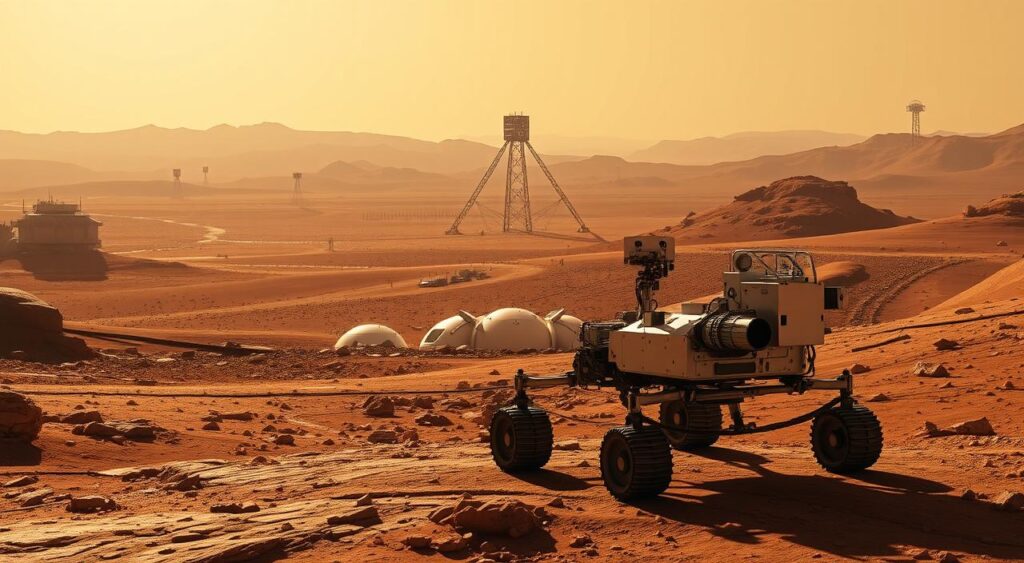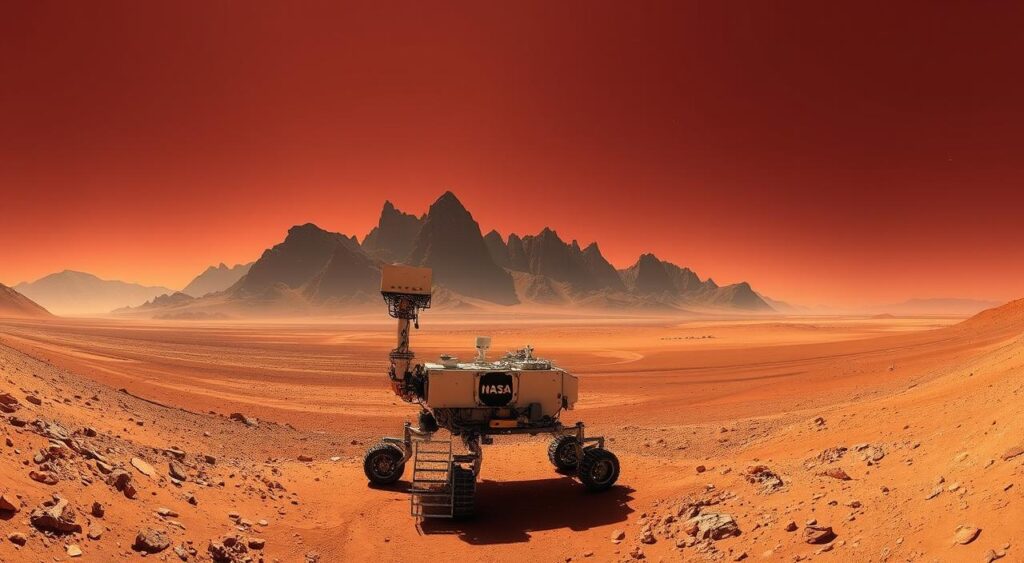I’m really excited about the latest in space exploration. The Perseverance rover on Mars has made some amazing discoveries. It uses AI to find minerals in Martian rocks. This is a big step forward in technology.
The AI helps PIXL, a tool made by NASA’s Jet Propulsion Laboratory. It makes the rover better at studying Martian geology. I find these advancements really interesting. They could change how we see Mars and its makeup.
AI in space travel is a huge leap. I’m eager to share my thoughts on what these discoveries mean for future missions.
Key Takeaways
- The Perseverance rover uses AI to analyze Martian rocks.
- AI technology supports PIXL, making geological analysis better.
- The discoveries have big implications for space exploration.
- The findings could change how we see Mars.
- AI integration is a big step in exploring planets.
The Evolution of Mars Exploration Technology

NASA’s Mars exploration has seen huge tech leaps. These changes have greatly improved our knowledge of Mars. The journey shows our endless drive for discovery.
From Sojourner to Perseverance: My Journey Following Mars Rovers
The Sojourner rover was a big step in Mars exploration, launched in 1996. It led to the Spirit and Opportunity rovers, which changed how we see Martian geology. Now, the Perseverance rover uses AI to study Martian samples and terrain.
The Game-Changing Role of AI in Modern Space Exploration
AI has changed space exploration a lot. The Perseverance rover’s AI helps analyze minerals on Mars. This lets scientists find new things and understand Martian geology better. AI also helps the rover move around tough terrain more easily.
Why I’m Fascinated by NASA’s Technological Leaps
I love NASA’s tech advancements because they help us learn more about space. AI in Mars exploration opens up new ways to discover. It could lead to even more big discoveries in the future.
| Rover Mission | Launch Year | Key Technological Advancements |
|---|---|---|
| Sojourner | 1996 | Pioneered Mars rover technology |
| Spirit and Opportunity | 2003 | Advanced geological analysis capabilities |
| Perseverance | 2020 | AI-powered PIXL instrument, autonomous navigation |
NASA’s New AI-Powered Mars Rover Discoveries

Recent breakthroughs in Mars exploration, thanks to AI, have given us new insights. The Perseverance rover, with its advanced AI, has found new evidence about Martian geology and weather.
Groundbreaking Geological Findings That Changed My Understanding
The Perseverance rover’s AI-powered PIXL instrument has found minerals in Martian rocks. This has greatly improved our understanding of Martian geology. The AI software helps position the instrument and analyzes scans for minerals.
The Search for Ancient Microbial Life: Latest Updates
Discoveries of minerals linked to past water on Mars are key. “The presence of water is a critical factor in the search for life beyond Earth,” NASA scientists say. The rover’s AI instruments have been essential in analyzing samples for signs of past life.
How AI Algorithms Are Decoding Martian Weather Patterns
AI algorithms are key in understanding Martian weather patterns. This analysis helps scientists grasp the Martian climate and its life-supporting capabilities. AI processes vast data to reveal patterns we didn’t know existed.
NASA’s use of AI in Mars missions shows the power of technology in space exploration. As we keep exploring Mars, AI-driven discoveries will be key to understanding the Red Planet.
Behind the Scenes: The AI Technologies Driving These Discoveries
https://www.youtube.com/watch?v=mjqH3HoMhfQ
I’m amazed by the AI that helps NASA’s Mars rovers discover so much. The Perseverance rover is a standout, thanks to its advanced AI. It’s a true marvel of engineering.
AEGIS and Other Machine Learning Systems Onboard Perseverance
The Perseverance rover has many AI and machine learning systems. AEGIS (Autonomous Exploration for Gathering Increased Science) is one. It lets the rover pick its own targets for study, boosting its science power.
Other systems help analyze data and make decisions quickly. This makes the rover more efficient and effective in its search.
Autonomous Navigation and Sample Collection Capabilities
The Perseverance rover can move and collect samples on its own. It uses AI to autonomously navigate Mars, avoiding dangers and finding the best places to collect samples. This is key to the mission’s success.
- Autonomous navigation through Martian terrain
- Real-time obstacle avoidance
- Intelligent sample collection and prioritization
Real-Time Data Processing: The Features That Impress Me Most
The Perseverance rover can process data as it’s gathered. AI algorithms analyze it instantly, letting the rover adjust its plans as needed. This is a big leap forward from older missions, where data was sent back to Earth.
AI has changed Mars exploration for the better. It lets rovers like Perseverance do more than ever before. As we keep exploring, AI will play an even bigger role, leading to new discoveries and insights.
What These Mars Discoveries Mean for Future Space Exploration
NASA’s latest Mars discoveries are exciting for space exploration’s future. The Mars rover missions are teaching us a lot about the Red Planet. They also open doors for even bigger space projects.
NASA’s Upcoming Mars Sample Return Mission and AI’s Role
NASA’s Perseverance rover is part of a big mission to Mars. It aims to bring back samples for study on Earth. AI is key in this mission, helping the rover find and collect samples. AI will also help decide which samples to send back to Earth.
The Potentia for Human-AI Collaborative Missions to Mars
AI could make Mars missions better by working with humans. In future missions, AI could help astronauts. It could guide them, do experiments, and make quick decisions. This teamwork could make Mars missions more successful.
Implications for India’s Space Research Organization and My Hopes
The progress in Mars exploration and AI in space is big news for space research worldwide. I hope it leads to more teamwork between NASA and India’s Space Research Organization (ISRO). This could lead to even more exciting and successful space missions.
Conclusion
NASA’s new AI-powered Mars rover discoveries are a big deal. They show how far technology has come in exploring space. The Perseverance rover’s AI has led to major scientific finds, changing how we see Mars and its life possibilities.
AI in space research is a game-changer. It makes collecting and analyzing data much better. As we keep exploring Mars and other planets, AI will be key in understanding our universe.
I’m looking forward to what these discoveries mean for space travel. Groups like the Indian Space Research Organization will benefit a lot. With AI, we might see humans and AI working together on Mars missions soon. This could spark a new wave of interest in space.
